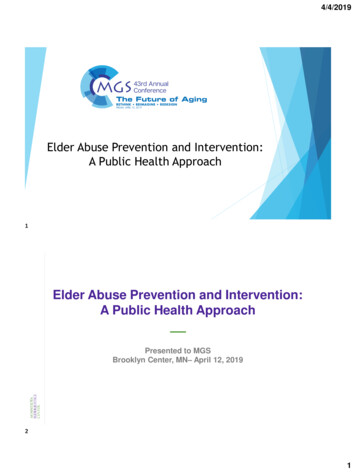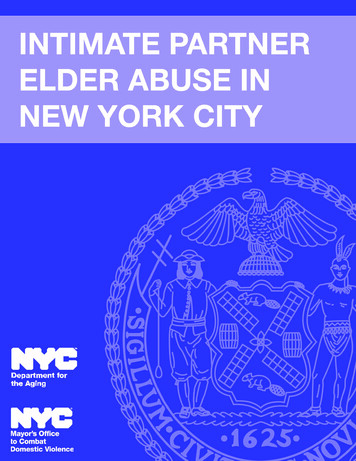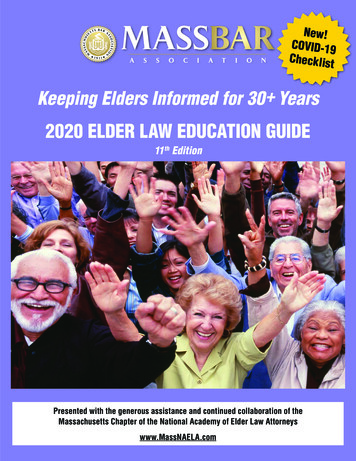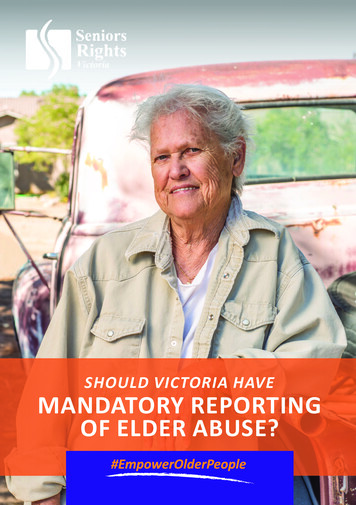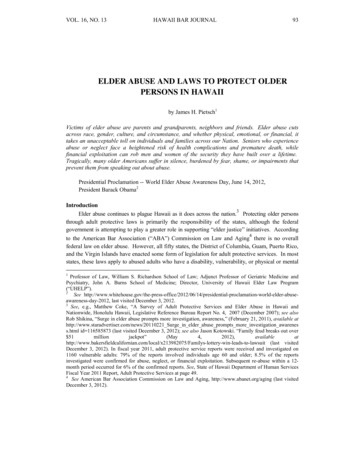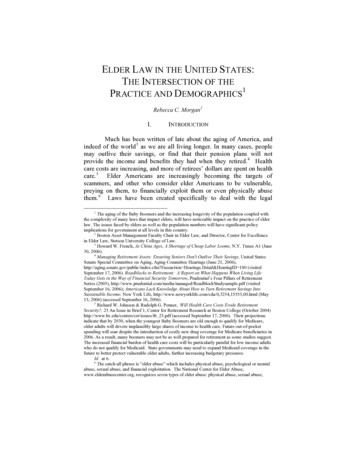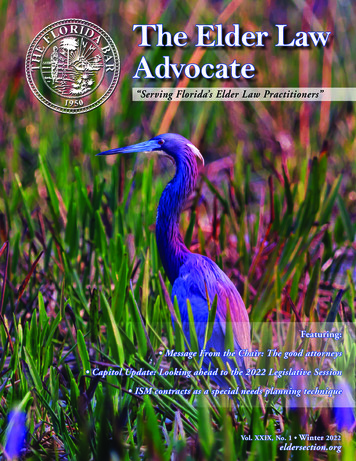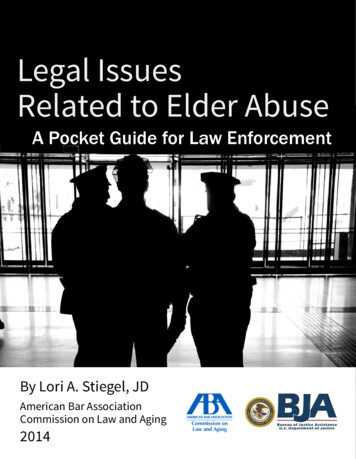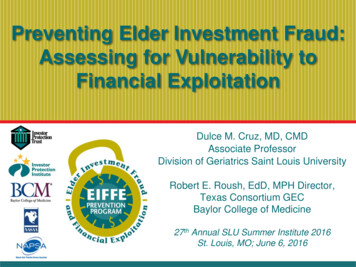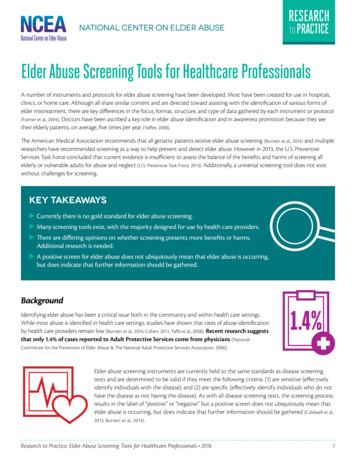
Transcription
NATIONAL CENTER ON ELDER ABUSERESEARCHto PRACTICEElder Abuse Screening Tools for Healthcare ProfessionalsA number of instruments and protocols for elder abuse screening have been developed. Most have been created for use in hospitals,clinics, or home care. Although all share similar content and are directed toward assisting with the identification of various forms ofelder mistreatment, there are key differences in the focus, format, structure, and type of data gathered by each instrument or protocol(Fulmer et al., 2004). Doctors have been ascribed a key role in elder abuse identification and in awareness promotion because they seetheir elderly patients, on average, five times per year (Yaffee, 2008).The American Medical Association recommends that all geriatric patients receive elder abuse screening (Burnett et al., 2014) and multipleresearchers have recommended screening as a way to help prevent and detect elder abuse. However in 2013, the U.S. PreventiveServices Task Force concluded that current evidence is insufficient to assess the balance of the benefits and harms of screening allelderly or vulnerable adults for abuse and neglect (U.S. Preventive Task Force, 2013). Additionally, a universal screening tool does not existwithout challenges for screening.Key Takeawaysuu Currently there is no gold standard for elder abuse screening.uu Many screening tools exist, with the majority designed for use by health care providers.uu There are differing opinions on whether screening presents more benefits or harms.Additional research is needed.uu A positive screen for elder abuse does not ubiquitously mean that elder abuse is occurring,but does indicate that further information should be gathered.BackgroundIdentifying elder abuse has been a critical issue both in the community and within health care settings.While most abuse is identified in health care settings, studies have shown that rates of abuse identificationby health care providers remain low (Burnett et al., 2014, Cohen, 2011, Yaffe et al., 2008). Recent research suggeststhat only 1.4% of cases reported to Adult Protective Services come from physicians (NationalCommittee for the Prevention of Elder Abuse & The National Adult Protective Services Association, 2006).Elder abuse screening instruments are currently held to the same standards as disease screeningtests and are determined to be valid if they meet the following criteria: (1) are sensitive (effectivelyidentify individuals with the disease); and (2) are specific (effectively identify individuals who do nothave the disease as not having the disease). As with all disease screening tests, the screening processresults in the label of “positive” or “negative” but a positive screen does not ubiquitously mean thatelder abuse is occurring, but does indicate that further information should be gathered (Caldwell et al.,2013, Burnett et al., 2014).Research to Practice: Elder Abuse Screening Tools for Healthcare Professionals 2016 1
Screening ToolsAt the Elder Mistreatment Symposium convened by the Centers for Medicare and Medicaid Services in2013, three screening tools (presented in table below) were identified for increased use in practice for thescreening of elder mistreatment. These tools were identified for their ability to assess multiple types of abuse,for the specifications of the measure, and for the focus of each tool when combined (McMullen et al., 2014).These tools are intended to be used by trained professionals in healthcare SSETTINGCompleted by health care professional toassess risk, neglect, verbal, psychological,emotional, financial, physical and sexualabuse over a 12 month period; 2 minutesto completeSensitivity: 0.77Validated in familypractices andambulatory caresettingsELDER ABUSESUSPICION INDEX(EASI)6HWALEK-SENGSTOCKELDER ABUSESCREENING TEST(H-S/EAST)6Self-report or interview by a professionalConstruct and predictivevalidity, weak itemreliability, but good crosscultural adaptationSuitable inemergency oroutpatient settingVULNERABILITY TOABUSE SCREENINGSCALE (VASS)12Self-report of dependency, dejection,coercion, and vulnerabilityModerate ranges ofreliability and moderate togood construct validityN/ASpecificity: 0.44(Burnett et al., 2014)Other Elder Abuse Screening Tools:WITH PSYCHOMETRICS:WITHOUT PSYCHOMETRICS: Brief Elder Screen for the Elderly (BASE) (Reis et al., 1993) Case Detection Guidelines (Rathbone-McCuan, 1980) Caregiver Abuse Screen (CASE) (Reis & Namiash, 1995) Elder Abuse and Neglect Protocol (Tomita, 1983) Elder Assessment Instrument (EAI) (Fulmer & O'Malley, 1987) Health, Attitudes towards aging, Livingarrangements, and Finances (H.A.L.F.) Expanded Indicators of Abuse (E-IOA) (Cohen et al., 2006) Geriatrics Mistreatment Scale (GMS) (Giraldo-Rodríguez & Rosas-Carrasco, 2013) Indicators of Abuse (IOA) (Reis & Nahmiash, 1998)(Ferguson & Beck, 1983) Screening Protocols for the Identification of Abuseand Neglect in the Elderly (Johnson, 1981) Older Adult Financial Exploitation Measure (OAFEM) (Conrad et al., 2010) Screening Tools and Referral Protocol Stopping Abuse Against OlderOhioans: A Guide for Service Providers (Bass et al., 2001) Self-disclosure tool (Cohen et al., 2007) Signs of abuse inventory (Cohen, 2011)Research to Practice: Elder Abuse Screening Tools for Healthcare Professionals 2016 2
SettingsStudies of various elder abuse screening tools have been conducted in various health care settings. Basic justifications for screeningin certain settings and findings of these studies are presented below. This list is not exhaustive. Other healthcare specialists such asorthopedic surgeons, optometrists, plastic surgeons, and dermatologists may also be effective in screening for elder abuse.PRIMARY CAREElders are seen in primary care settings for common conditions associated with aging. Therefore, primary caresettings may provide a valuable opportunity for elder abuse screening. Caldwell et al. examined various tools usedin primary care settings, and found two with good internal validity – the OAFEM and EASI. However, they notethat external validity is difficult to measure because there is no ‘gold standard’ for comparison (Caldwell et al., 2013).DENTAL CLINICSFulmer and colleagues (2012) studied the feasibility of screening for elder mistreatment in busy clinics, includingdental clinics, using an adapted version of the Elder Assessment Instrument (EAI). It was found that screeningin dental clinics was feasible and study participants were willing to enroll in the study regardless of the sensitivenature of the survey questions (Fulmer et al., 2012).HOME HEALTH SETTINGSPickering et al. (2016) suggest that professionals working in home healthcare have an advantageous positionto identify and report elder abuse and neglect because they directly observe most assessment criteria.Furthermore, this is an important setting for elder abuse assessment as older adults are receiving more servicesfrom home healthcare providers. They indicate that the use of a tool such as the QualCare scale – focused onidentifying the met and unmet needs of the older adults regardless of the mechanisms causing them – canincrease identification and reporting of abuse (Pickering et al., 2016).EMERGENCY DEPARTMENTSEmergency departments (EDs) have become critical sites for detection of child abuse but the same has nothappened for elder abuse despite its prevalence and the potential value of identifying it in the ED (Rosen et al.,2016). EDs serve an important role when older adults interface with healthcare services, and ED nurses may beable to recognize and identify abuse (Phelan, 2012).OB/GYN CLINICSGiven that women are at an increased risk for elder abuse, OB/GYNs may play a fundamental role in screeningfor elder abuse. In a study, Leddy et al. (2014) found that routine screening is not currently being conducteddue to time constraints, uncertainty about where to call for help and lack of professional protocols on how torespond to abuse. The study indicated a need for greater education and training for elder abuse screening (Leddyet al., 2014).LONG-TERM CARE SETTINGSLong-term care settings including nursing homes and skilled nursing facilities present opportunities forscreening and detection of elder abuse. Cohen (2011) indicates studies have found that data on the prevalenceof abuse or neglect in long-term care institutions is lacking, in part, due to inadequate procedures for itsassessment and identification. While many tools have been suggested and tested for use in the long-term caresetting, they need to be further validated to encompass possible abusive behaviors that may be characteristic ofinstitutions (Cohen et al., 2010).Research to Practice: Elder Abuse Screening Tools for Healthcare Professionals 2016 3
Potential Benefits and Potential Harms of Screeningpotential benefitspotential harmsuu Screening is critical for early detection andprevention of elder abuse (Burnett et al., 2014).uu Screening poses an additional challenge for APSagencies, which are already overwhelmed andunder-resourced (O’Brien in Dong, 2015).uu Similar to IPV screening for pregnant women,elder abuse screening does not present anynoticeable harm. Even if potential benefits areunclear, they are possible (Dong, 2015).uu An encounter with a professional may bean elder’s only chance to change an abusivesituation and prevent its continuation orexacerbation (Cohen, 2011).uu Early detection and interventions as a resultof screening may help ameliorate or stopelder abuse (Dong, 2015).uu There is a perceived lack of response to screening,detection, and reporting, which may lead to even lessreporting by healthcare providers (O’Brien in Dong, 2015).uu Initiatives to promote awareness of elder abuse areencouraging, but fail to meet threshold to justifyscreening (O’Brien in Dong, 2015).uu Existing tools are problematic because they don’tdetect common forms of abuse including financial andneglect (O’Brien in Dong, 2015).Challenges and Future DirectionsDESIGNING A SCREENING TOOL A simple, brief screening and assessment methodology is needed (Caldwell et al., 2013, Fulmer et al., 2004) A criterion standard for the diagnosis or validation of elder abuse is lacking (Fulmer et al., 2004, Yaffe et al., 2008,McMullen et al., 2014, Cohen, 2011)EVALUATION A “gold standard” comparison for establishing the validity of elder abuse screening tools does not exist (Caldwell et al., 2013).Good-quality randomized, controlled trials focusing on both screening and interventions are needed (U.S. Preventive Task Force, 2013).CHALLENGES FOR PHYSICIANS Normal aging changes can mimic signs of elder abuse (Fulmer et al., 2004, Lachs & Rosen, 2016, Cohen, 2011) Screening tools that take more than an hour to administer meet with increased resistance which decreases screening quality(Cohen, 2011, Yaffe et al., 2008, Fulmer et al., 2004). Differentiating between unintentional and intentional injuries and between illnesses thatoccurred despite appropriate care or as a result of neglect is also time consuming (Bond et al., 2013, Gibbs, 2014). Screening cognitively impaired elders can be challenging because physical findings and diagnostic results may be the only source ofinformation to determine the presence of abuse (Rosen et al., 2016, McMullen et al., 2014). Elder victims may be reluctant to disclose evidence of abuse to professionals out of fear, shame, or a sense of hopelessness(Fulmer et al., 2004, Fulmer, 2008, Rosen et al., 2016). Concerns of elder abuse may create significant additional work and propel the clinician into a world that he or she is likely to be unfamiliarwith (mandatory reporting statutes, adult protective service workers, and a criminal justice system) (Lachs & Rosen, 2016, Rosen et al., 2016). Providers may be skeptical about the possibility of making a change once elder abuse is identified and reported (Rosen et al., 2016, Yaffe et al., 2008)NEW APPROACHES TO SCREENING Research on a team-based approach to identifying elder abuse in emergency departments may be useful. This would involveleveraging the unique perspectives of emergency medical services providers, triage providers, nurses, radiologists, radiologytechnicians, social workers, and case managers (Rosen et al., 2016). Research on how diagnostic radiologists can incorporate detection of elder abuse into their practice may be beneficial. Radiologytechnicians and other employees such as nursing assistants who transport patients are uniquely positioned to receive such reportsbecause they often spend time alone with the patient (Sidley & Southerland, 2015). NIJ has funded two projects related to elder abuse screening that are currently underway. For more information, pages/addressing.aspx (National Institute of Justice, 2016).Research to Practice: Elder Abuse Screening Tools for Healthcare Professionals 2016 4
What to Do If Abuse Is SuspectedWhenever a reasonable suspicion of abuse arises, including a positive screen, it should be reported to the appropriate agency to befurther investigated. States vary in reporting laws and procedures. The Eldercare Locator ex.aspx) can be used to identify the appropriate local elder abuse reporting agency and contact information.ReferencesBass, D.M., Anetzberger, G.J., Ejaz, F.K., & Nagpaul, K. (2001). Screening tools andreferral protocol for stopping abuse against older ohioans: a guide for service providers.Journal of Elder Abuse & Neglect, 13(2), 23-38. Retrieved from http://dx.doi.org/10.1300/J084v13n02 03Bond, M.C., & Butler, K.H. (2013). Elder abuse and neglect: definitions, epidemiology, andapproaches to emergency department screening. Clinical Geriatric Medicine, 29(1), 57-273.doi: 10.1016/j.cger.2012.09.004Burnett, J., Achenbaum, W., & Murphy, K. (2014). Prevention and early identification ofelder abuse. Clinics in Geriatric Medicine, 30(4), 743-59. doi: 10.1016/j.cger.2014.08.013Caldwell, H.K., Gilden, G., & Mueller, M. (2013). Elder abuse screening instruments inprimary care: an integrative review, 2004 to 2011. Clinical Geriatrics, 21(1), 20-25. Retrievedfrom ew-2004-2011Cohen, M. (2011). Screening tools for the identification of elder abuse. Journal of ClinicalOutcomes Management, 18(6), 261-270. Retrieved from http://www.turner-white.com/pdf/jcom jun11 abuse.pdfCohen, M., Halevy-Levin, S., Gagin, R., & Friedman, G. (2007). Elder abuse: disparitiesbetween older people’s disclosure of abuse, evident signs of abuse, and high risk ofabuse. Journal of the American Geriatrics Society, 55(8), 1224–30. doi: 10.1111/j.15325415.2007.01269.xCohen, M., Halevi-Levin, S., Gagin, R., & Friedman, G. (2006). Development of a screeningtool for identifying elderly people at risk of abuse by their caregivers. Journal of Aging andHealth 18(5), 660-685. doi: 10.1177/0898264306293257Cohen, M., Halevy-Levin, S., Gagin, R., Priltuzky, D., and Friedman, G. (2010). Elder Abuse inLong-term Care Residences and the Risk Indicators. Ageing and Society, 30(6), 1027-1040.doi: 10.1017/S0144686X10000188Conrad, K.J., Iris, M., Ridings, J.W., Langley, K., & Wilber, K.H. (2010). Self-report measureof financial exploitation of older adults. The Gerontologist, 50(6), 758-773. doi: 10.1093/geront/gnq054Dong, X. (2015). Screening for elder abuse in healthcare settings: Why should we care, andis it a missed quality indicator. Journal of the American Geriatrics Society, 63(8), 1686-1688.doi: 10.1111/jgs.13538Ferguson, D., & Beck, C. (1983). H.A.L.F.-A tool to assess elder abuse within the family.Geriatric Nursing, 4(5), 301-304. Retrieved from er, T. (2008). Screening for mistreatment of older adults. The American Journalof Nursing, 108(12), 52-60. Retrieved from 508Fulmer, T., Guadagno, L., Dyer, C.B., & Connolly, M.T. (2004). Progress in elder abusescreening and assessment tools. Journal of the American Geriatrics Society, 52(2), 297-304.doi: 10.1111/j.1532-5415.2004.52074.xFulmer, T., & O'Malley, T. (1987). Inadequate Care of the Elderly. New York: SpringerFulmer, T., Strauss, S., Russell, S., Geetika, S., Blankenship, J., Vemula, R., Caceres, B., Valenti,M., & Sutin, D. (2012). Screening for elder mistreatment in dental and medical clinics.Gerontology, 29(2), 96-105. doi: 10.1111/j.1741-2358.2010.00405.xGibbs, L.M. (2014). Understanding the medical markers of elder abuse and neglect: physicalexamination findings. Clinical Geriatric Medicine, 30(4), 687-712. doi: 10.1016/j.cger.2014.08.002Giraldo-Rodríguez, L., & Rosas-Carrasco, O. (2013). Development and psychometricproperties of the geriatric mistreatment scale. Geriatrics & Gerontology International,13(2), 466-74. doi: 10.1111/j.1447-0594.2012.00894.xLachs, M., & Rosen T. (In press). Elder Mistreatment. In Halter, J.B., Ouslander, J.G.,Studenski, S., High, K.P., Asthana, S., Supiano, M.A, & Ritchie, C.S. (Authors). Hazzard’sGeriatric Medicine and Gerontology, Seventh Edition. (In press)Leddy, M., Farrow, V., & Schulkin, J. (2014). Obstetrician-gynecologists' knowledge,attitudes, and practice regarding elder abuse screening. Women’s Health Issues, 24(4),e455-64. doi: 10.1016/j.whi.2014.04.006McMullen, T., Schwartz, K., Yaffe, M., & Beach, S. (2014). Elder abuse and its prevention:screening and detection. In IOM (Institute of Medicine) & NRC (National ResearchCouncil) (Eds.), Elder abuse and its prevention: Workshop summary (88-93). Washington,DC: The National Academies Press.National Institute of Justice. (2016). Addressing Elder Mistreatment. Department of Justice.Retrieved from addressing.aspx - note2Phelan, A. (2012). Elder abuse in the emergency department. International EmergencyNursing, 20(4), 214-220. doi:10.1016/j.ienj.2012.03.009Pickering, C.E., Ridenour, K., & Salaysay, Z. (2016). Best practices for the identification ofelder abuse and neglect in home health. Home Health Now, 34(4), 182-8. doi: 10.1097/NHH.0000000000000373Rathbone-McCuan, E. (1980). Elderly victims of family violence and neglect. SocialCasework, 61(5), 296–304. New York: Family Service America.Reis, M., & Nahmiash, D. (1995a). Validation of the caregiver abuse screen (CASE).Canadian Journal on Aging, 14(2, Suppl 2), 45-61. Retrieved from http://dx.doi.org/10.1017/S0714980800005584Reis, M., & Nahmiash, D. (1998). Validation of the Indicators of Abuse (IOA) Screen. TheGerontologist, 38(4), 471-480. Retrieved from 8/4/471.full.pdfReis, M., Nahmiash, D., & Shrier, R. (1993). A brief abuse screen for the elderly (base): itsvalidity and use. Paper presented at the 22nd Annual Scientific and Educational Meeting ofthe Canadian Association on Gerontology. Montreal, Quebec, Canada.Rosen, T., Hargarten, S., Flomenbaum, N., & Platts-Mills, T. (2016). Identifying elder abusein the emergency department: toward a multidisciplinary team-based approach. Annalsof Emergency Medicine. doi:10.1016/j.annemergmed.2016.01.037Sidley, C., & Southerland, LT. (2015). When a “fall” isn’t a fall: screening for eldermistreatment. Emergency Physicians Monthly. Retrieved from llscreening-for-elder-mistreatmentThe National Committee for the Prevention of Elder Abuse, & The National AdultProtective Services Association. (2006). The 2004 Survey of State Adult Protective Services:Abuse of Adults 60 Years of Age and Older. Retrieved from tive.pdfTomita, S. (1983). Detection and treatment of elderly abuse and neglect: a protocolfor health care professionals. Physical & Occupational Therapy In Geriatrics 2(2), 37–51.Retrieved from http://dx.doi.org/10.1080/J148v02n02 04U.S. Preventive Services Task Force. (2013). Final recommendation statement intimatepartner violence and abuse of elderly and vulnerable adults: Screening, January 2013.Retrieved from dults-screeningYaffe, M., Wolfson, C., Lithwick, M., & Weiss, D. (2008). Development and validationof a tool to improve physician identification of elder abuse: the elder abusesuspicion index (EASI). Journal of Elder Abuse and Neglect, 20(3), 276-300. doi:10.1080/08946560801973168Johnson D. (1981). Abuse of the elderly. The Nurse Practitioner 6(1), 29–34. doi:10.1097/00006205-198101000-00007This document was completed for the National Center on Elder Abuse situated at Keck School of Medicine of USC and is supported in part by a grant(No. 90AB0003-01-01) from the Administration on Aging (AOA), U.S. Department of Health and Human Services (DHHS). Grantees carrying out projects undergovernment sponsorship are encouraged to express freely their findings and conclusions. Therefore, points of view or opinions do not necessarily representofficial Administration on Aging or DHHS policy.Research to Practice: Elder Abuse Screening Tools for Healthcare Professionals 2016 5
Committee for the Prevention of Elder Abuse & The National Adult Protective Services Association, 2006). Elder abuse screening instruments are currently held to the same standards as disease screening . tests and are determined to be valid if they meet the following criteria: (1) are sensitive (effectively
